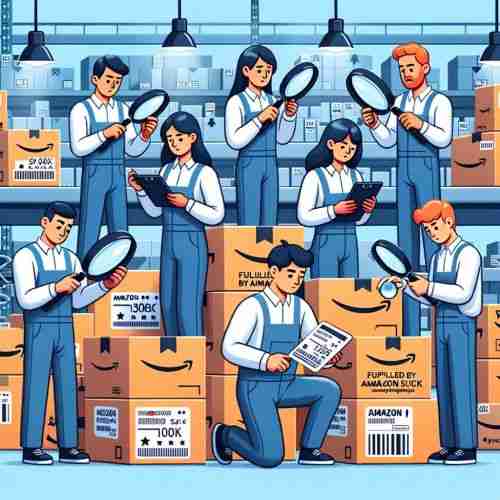Sisällysluettelo
ToggleAmazon FBA Product Inspection
Introduction
If you’re dabbling in the world of Amazon FBA (Fulfillment by Amazon), you probably already know that product quality is key to your success. But have you considered how crucial product inspection is? Let’s dig in.

Why Product Inspection Matters in Amazon FBA
Product inspection isn’t just a logistical step; it’s your shield against potential calamities. Imagine sending out hundreds of defective products; not only would you lose money, but your brand image would also suffer.
Quality Assurance
A meticulous inspection ensures that your products meet quality standards, which translates to happier customers and better reviews.
Customer Satisfaction
When customers receive what they expect, they are more likely to become repeat buyers.
Risk Mitigation
Inspections also help you avoid costly recalls and legal issues.
Types of Amazon FBA Product Inspections
Pre-Shipment Inspection
This is your final opportunity to catch any issues before your items ship.
- The pre-shipment inspection, often referred to as PSI, serves as your final line of defense before your products leave the manufacturing facility and head to Amazon’s fulfillment centers. This critical inspection occurs at the conclusion of the production process, allowing you to catch any potential issues, defects, or discrepancies before your items are shipped.
- Key elements of pre-shipment inspection include checking product quality, quantity, packaging, labeling, and compliance with Amazon’s requirements. Any deviations from your specifications or Amazon’s guidelines can be identified and addressed at this stage, helping to prevent costly issues and negative customer feedback.
During Production Inspection
This is performed while your products are still in the manufacturing phase.
- The during production inspection, also known as DPI or in-process inspection, takes place while your products are still in the manufacturing phase. This proactive approach allows you to monitor the production process and address any concerns before they become major issues.
- During this inspection, trained quality control professionals visit the factory to assess various aspects of production, including materials, workmanship, and quality standards. They may review the production schedule, conduct random product sampling, and ensure that your product specifications are being met. By doing so, you can prevent potential problems and make necessary adjustments before the manufacturing process is complete.
These two types of inspections are integral to maintaining product quality, adhering to Amazon’s stringent requirements, and ultimately ensuring customer satisfaction. While the pre-shipment inspection serves as a final check to catch any last-minute discrepancies, the during production inspection offers real-time monitoring to address issues at their source. By incorporating both types of inspections into your quality control process, you can significantly enhance the reliability and success of your Amazon FBA business.
Container Loading Inspection
Container loading inspection is a crucial step in the logistics and shipping process, primarily undertaken to ensure that products are correctly and securely loaded into shipping containers before they embark on their journey to their destination. This meticulous inspection serves several vital purposes:
1. Product Safety:
- Proper loading is essential to safeguard the integrity of the products being shipped. It helps prevent damage during transit, ensuring that the items arrive at their destination in the same condition as when they left the manufacturer or supplier.
2. Maximizing Container Space:
- Efficient packing ensures that every inch of container space is utilized effectively. This can help reduce shipping costs by allowing more products to be transported in a single shipment, optimizing logistics expenses.
3. Compliance with Regulations:
- Container loading inspections also help ensure compliance with international shipping regulations and standards. Different countries may have specific requirements for how goods should be loaded, and adhering to these guidelines is critical to avoiding delays or fines at customs checkpoints.
4. Minimizing Shifting and Movement:
- During transit, containers may be subject to various forces, such as vibration and rough handling. Properly secured cargo reduces the risk of items shifting or moving within the container, which can lead to damage or safety hazards.
5. Quality Control:
- Container loading inspection is an integral part of quality control in the supply chain. It allows for a final check to ensure that the correct products, quantities, and packaging are being shipped, reducing the chances of shipping errors.
6. Peace of Mind:
- Importers and exporters benefit from container loading inspections as they provide peace of mind. Knowing that products have been loaded correctly reduces anxiety about potential shipping mishaps and damages.
To carry out a container loading inspection effectively, trained inspectors verify the loading process, the condition of packaging, and the securing of products within the container. They may use various tools and equipment to assess the stability of the cargo.
In conclusion, container loading inspection is a critical quality control measure that helps guarantee the safe and efficient shipment of goods. It’s an investment that pays off by reducing the risks of damage, ensuring compliance, and providing confidence in the shipping process for both buyers and sellers.
Tarkastusprosessi
Pre-inspection Planning
The first step involves determining what you need to inspect and how.
- The first step in the inspection process is meticulous planning. This involves determining precisely what aspects of the products need to be inspected and defining the inspection criteria. It’s essential to establish clear guidelines for the inspection team, including what to look for and how to assess product quality.
- Pre-inspection planning also includes selecting random samples for evaluation. These samples should be representative of the entire batch to ensure accurate results.
On-site Inspection
This involves the actual process of examining the products.
- The on-site inspection is where the actual examination of the products takes place. Trained inspectors visit the manufacturing facility or supplier’s location to assess the products according to the predefined criteria.
- During this phase, the inspectors conduct a detailed examination of the products, checking for defects, damages, adherence to specifications, labeling accuracy, and any other relevant factors. They may also verify product quantities and packaging integrity.
- The on-site inspection is a critical step to identify and address any issues or discrepancies in real-time, preventing potentially subpar products from reaching Amazon’s fulfillment centers and, ultimately, customers.
Post-inspection Reporting
Includes documentation that could be crucial for future batches or legal issues.
- Post-inspection reporting involves documenting the findings and results of the inspection process. This documentation serves multiple purposes:
- It provides a clear record of the inspection process and its outcomes, which can be crucial for future reference.
- In the event of any disputes or legal issues, the inspection report can serve as essential evidence.
- It can help improve future batches by identifying recurring issues and areas for enhancement.
- The report typically includes detailed information about the inspection process, the condition of the sampled products, any identified defects, and recommendations for corrective actions if needed.
A well-structured inspection process, including pre-inspection planning, on-site inspection, and post-inspection reporting, is fundamental to maintaining product quality and ensuring that your Amazon FBA business operates smoothly. By following these steps, you can enhance the reliability of your product supply chain and minimize the risks associated with subpar products reaching your customers.
Hiring a Third-Party Inspection Company
Pros and Cons
Hiring experts is often more effective but can be costly.
Cost Estimates
Expect to spend anywhere from $300 to $600 per inspection.
Doing the Inspection Yourself
Pros and Cons
It’s more affordable but may be less accurate if you’re not an expert.
Steps Involved
This could involve the use of specialized equipment and know-how.
Tools and Technologies for Inspection
Traditional Tools
Includes stuff like tape measures, calipers, and scales.
Modern Technologies
Think digital imaging and 3D scanning.
Common Pitfalls in Product Inspection
While product inspection is a crucial quality control process, several common pitfalls can hinder its effectiveness. Being aware of these pitfalls is essential for ensuring that your inspection process runs smoothly and achieves its intended goals. Here are two common pitfalls to watch out for:
1. Inadequate Planning:
- One of the most significant pitfalls in product inspection is inadequate planning. Rushing into an inspection without a well-defined plan can lead to several issues. Without clear criteria and guidelines, inspectors may miss critical quality issues or waste time checking irrelevant aspects of the product.
- Inadequate planning can also result in confusion among the inspection team, leading to inconsistent evaluations and unreliable results. Additionally, without proper planning, you may allocate resources inefficiently, causing unnecessary delays and expenses.
2. Inexperienced Inspectors:
- The competence and experience of the inspection team are paramount to the success of the inspection process. Relying on inexperienced inspectors or inspectors who lack the necessary training can be a costly mistake in the long run.
- Inexperienced inspectors may fail to identify quality issues, misinterpret specifications, or make errors in judgment. These mistakes can result in subpar products being shipped to customers, leading to customer complaints, returns, and damage to your brand’s reputation.
- To mitigate this pitfall, invest in well-trained and experienced inspectors who are familiar with your industry, product specifications, and quality standards.
Avoiding these common pitfalls is essential to ensuring that your product inspection process is effective and provides accurate insights into the quality of your products. Proper planning and the use of experienced inspectors can help you identify and address issues early in the production process, ultimately contributing to the success of your Amazon FBA business.
How to Avoid Inspection Mistakes
Preventing inspection mistakes is crucial for maintaining product quality and the reputation of your Amazon FBA business. To ensure a smooth and effective inspection process, consider the following strategies
1. Preemptive Measures:
- Taking proactive steps before the inspection can save you a lot of headaches in the long run. This includes thorough pre-inspection planning. Define clear inspection criteria, guidelines, and expectations for the inspection team. Ensure that they understand the specific quality standards, product specifications, and any relevant regulatory requirements.
- Conduct regular meetings and training sessions to keep your inspection team up-to-date on changes in your product line or quality expectations. This ongoing communication helps prevent misunderstandings and ensures that everyone is on the same page.
- Additionally, establish a robust communication channel with your suppliers or manufacturers to address any potential issues well in advance of the inspection. Timely dialogue can help resolve issues at the source and prevent them from reaching the inspection phase.
2. Contingency Plans:
- No matter how well you plan, unexpected situations can still arise. It’s essential always to have a plan B or contingency plan in place. This includes preparing for unforeseen events such as equipment failure, sudden production delays, or transportation issues.
- Identify potential bottlenecks or risks in your supply chain that could impact the inspection process. Develop alternative strategies or backup suppliers to address these challenges if they occur. Having contingency plans in place ensures that you can adapt quickly to unexpected circumstances without compromising product quality or delivery timelines.
By adopting preemptive measures and establishing robust contingency plans, you can significantly reduce the likelihood of inspection mistakes and their associated consequences. These proactive approaches not only enhance your quality control efforts but also contribute to the overall success and reliability of your Amazon FBA business.
Amazon FBA Inspection Regulations
Ensuring that your products meet Amazon’s stringent quality standards is vital to your success as an Amazon FBA seller. Amazon’s policies and the legal requirements associated with certain products are crucial aspects of the inspection process that you must be aware of:
1. Amazon’s Policies:
- Amazon is renowned for its unwavering commitment to customer satisfaction and safety. Consequently, the company is exceptionally strict about the quality of products that are sold on its platform through the FBA program. As an FBA seller, you must adhere to Amazon’s policies and guidelines for product quality, safety, and authenticity.
- These policies cover various aspects, including product condition, packaging, labeling, and compliance with safety standards. Failure to meet these standards can result in penalties, account suspension, or even removal of your listings from the platform.
2. Legal Requirements:
- In addition to Amazon’s policies, some products may be subject to specific legal and regulatory requirements. These requirements can vary widely depending on the nature of the products you sell and the regions where you operate.
- For instance, certain categories like electronics, toys, cosmetics, and food items may be subject to strict regulations regarding safety, labeling, and certification. Non-compliance with these legal requirements can lead to serious consequences, including legal actions, recalls, or fines.
- To avoid legal complications, it’s crucial to thoroughly research and understand the regulations that pertain to your products in the regions where you do business. This may involve obtaining necessary certifications, conducting safety tests, and ensuring proper labeling and documentation.
Compliance with Amazon’s policies and legal requirements is non-negotiable for Amazon FBA sellers. Failing to meet these standards can have severe repercussions, including damage to your business’s reputation and legal consequences. Therefore, it’s imperative to stay informed about the specific regulations that apply to your products and invest in thorough inspection processes to guarantee compliance and product quality.
Amazon’s Role in Inspection
Quality Checks
Amazon does perform some quality checks, but these are usually minimal.
Penalties and Privileges
Amazon will penalize sellers for poor quality but also reward good performance.
Impact on Seller Ratings
Positive Impact
Good ratings often correlate with consistent product quality.
Negative Impact
Poor inspections can lead to a drop in seller ratings.
Future Trends in FBA Product Inspection
Automation
Automated inspections are becoming increasingly prevalent.
AI and ML Applications
Imagine AI-based inspection systems; they are closer than you think.
Päätelmä
In the cutthroat environment of Amazon FBA, neglecting product inspection is akin to sailing a rickety ship without a compass. As we’ve seen, meticulous inspections can literally make or break your business.
UKK
- How much does a typical Amazon FBA product inspection cost?
- The cost can vary but expect to spend around $300 to $600 per inspection.
- Can I perform the inspection myself?
- Yes, but ensure you’re equipped with the right tools and knowledge.
- What are the types of inspections for Amazon FBA?
- Pre-Shipment, During Production, and Container Loading are the primary types.
- Does Amazon perform product inspections?
- Amazon does perform some basic quality checks but they are minimal.
- What happens if my product fails an inspection?
- Amazon could impose penalties, including removal of your product listings.
Kuinka hyödyllinen tämä viesti oli?
Arvioi se klikkaamalla tähteä!
Keskimääräinen luokitus 0 / 5. Äänten määrä: 0
Ei ääniä toistaiseksi! Ole ensimmäinen, joka arvioi tämän viestin.




